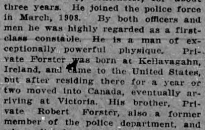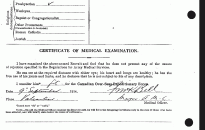Overview

John George Forster was born on 6 August 1883 at Kellavaghan, Ireland. He was the older brother of Robert Forster and the two would eventually migrate to Victoria, British Columbia. The brothers would become police officers in Victoria and later enlist in the Canadian Expeditionary Force at the outbreak of the Great War. He would serve with the 16th C.E.F. Battalion from 9 February to 25 April 1915, being wounded on 22 April 1915 during the Second Battle of Ypres. J.G. Forster would return to England where he would serve with the chief of military personnel for the duration of the war. His medical record lists him as 5 feet and 10 ½ inches, having a “fresh” complexion, blue eyes, and dark brown hair turning grey. He was listed as belonging to the Church of England.[1] John Forster “was highly regarded as a first-class constable” by “both officers and men” with an “exceptionally powerful physique.”[2]
Before Deployment Overseas
John and his brother Robert were born in Kellavaghan, Ireland.[3] He was the older of the two and they would later move to Victoria, British Columbia. Sometime after arriving, they became police officers. There is some discrepancy as to whether he had previously joined the 50th (Gordon Highlanders) prior to enlisting in the Canadian Expeditionary Force. According to the battalion roll call of the 16th C.E.F.’s “A” Company, the Gordon Highlanders are listed as his “previous corps”[4] while his attestation paper he states to have not served in a prior military force.[5] It is possible he was part of the reserve militia and did not serve extensively in any other military unit. Regardless, he enlisted in the Canadian Expeditionary Force and went, with his brother and fellow police officers from Victoria, to Quebec. Upon arrival in Valcartier, Quebec, John Forster listed “David Forster” as his next-of-kin, but it is unknown as to the nature of their relationship.
Military Service
Private John Forster arrived in France with his battalion on 9 February 1915. He would later fight during the Second Battle of Ypres at St-Julien where he was injured on 22 April 1915[6] while attached to the stretcher bearer company of the 16th C.E.F. Battalion.[7] After the battle, he was evacuated to England.

Forster was reassigned to the Chief of Military Personnel responsible for the management of soldiers in England[8] where he would remain for the rest of the war.[9] He was promoted to assistant/staff sergeant on 4 January 1919 and would be “struck-off-strength” on 11 August 1919.[10]
Post Military Service
John Forster would return to Victoria by 1920. John’s brother Robert was hit by an incoming automobile while riding his motorcyle on 10 November. John would be at Robert’s bedside at 8:00 PM on 11 November 1920 when the latter passed away due to injuries from the accident.[11]
Written by Joseph Yuson.
References
[1] Forster, John George. Service No. 28619. “Attestation Papers, 2.” Victoria, Canada: University of Victoria Special Collections. RG 150, Accession 1992-93/166, Box 3210-38.
[2] “Lists Contain Local Names: Several Victorians Fell in the Recent Fighting North of Ypres-Brother of Col. Ogilvie Wounded in Arm.” Daily Colonist, 30 April 1915, 1. http://archive.org/stream/dailycolonist57y121uvic#page/n0/mode/1up.
[3] Forster, “Attestation Papers,” 2.
[4] Battalion Roll Call, “A” Company, 9.
[5] Forster, “Attestation Papers,” 2.
[6] Lieutenant-Colonel H. M. Urquhart. The History of the 16th Battalion (The Canadian Scottish) Canadian Expeditionary Force in the Great War, 1914-1919. Toronto: MacMillan Company of Canada, 1932.
[7] “Lists Contain Local Names,” Daily Colonist, 30 April 1915, 1. http://archive.org/stream/dailycolonist57y121uvic#page/n0/mode/1up/search/forster+police.
[8] “Chief of Military Personnel,” National Defence and the Canadian Armed Forces. http://www.forces.gc.ca/en/about-org-structure/chief-military-personnel.page.
[9] Ibid.
[10] Ibid.
[11] “Fallen Heroes: Robert Forster.” VICPD. https://vicpd.ca/aboutus/history/fallen-heroes/.

